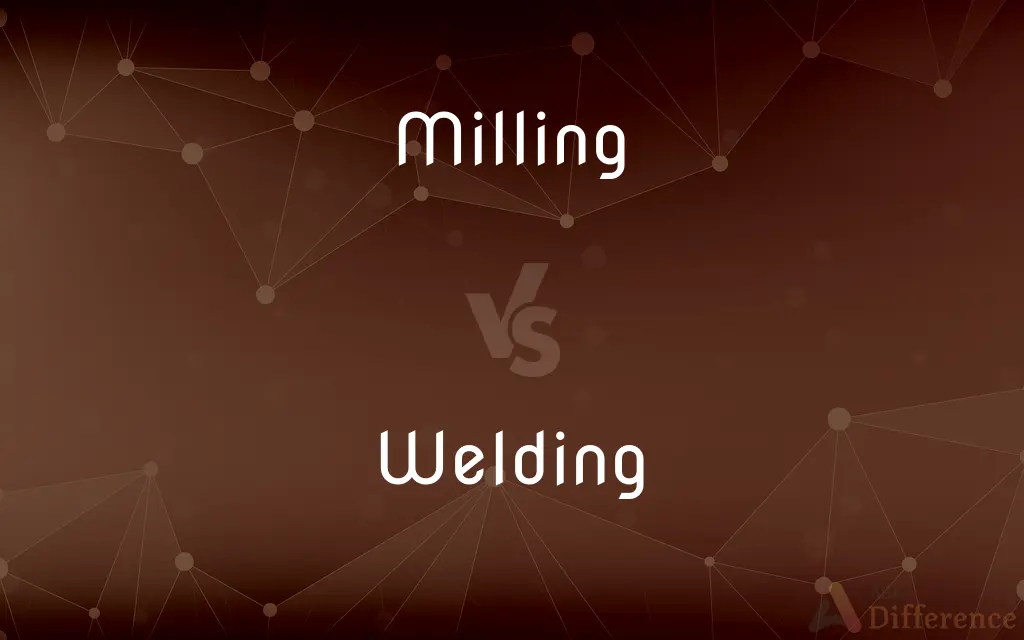Milling vs. Welding — What's the Difference?
By Tayyaba Rehman & Maham Liaqat — Published on February 25, 2024
Milling is a subtractive manufacturing process that removes material to shape parts, while welding is a joining technique that fuses materials together.

Difference Between Milling and Welding
Table of Contents
ADVERTISEMENT
Key Differences
Milling involves using rotating cutting tools to remove material from a workpiece, creating parts with precise dimensions and shapes. This process is versatile, capable of producing a wide range of features like slots, holes, and contours. Welding, on the other hand, is about joining two or more pieces of material (usually metal) by melting them together, often with a filler material. It's a fundamental technique for constructing and repairing structures and components.
The equipment used in milling and welding differs significantly. Milling machines, which can be manually operated or CNC (Computer Numerical Control) controlled, are designed for precision and can handle complex geometries. Welding equipment varies based on the welding method (e.g., MIG, TIG, Stick) and includes welding machines, torches, and protective gear, emphasizing the fusion of materials rather than material removal.
Materials suitable for each process also vary. Milling can be performed on a wide range of materials, including metals, plastics, and composites, depending on the cutting tool material. Welding is primarily used with metals and thermoplastics, with the specific technique depending on the material properties like melting point and thermal conductivity.
The skill set required for milling and welding is distinct. Milling requires understanding of machining principles, tool selection, and often programming skills for CNC milling. Welding demands knowledge of metallurgy, welding techniques, and safety practices, including proper handling of welding equipment and protective measures against intense heat and light.
Environmental and safety considerations are paramount in both processes. Milling can produce significant waste from removed material and requires measures to manage chips and coolants. Welding involves risks from high temperatures, molten metal, and potentially harmful fumes, necessitating proper ventilation and protective equipment.
ADVERTISEMENT
Comparison Chart
Process
Subtractive, removes material
Additive, joins materials
Equipment
Milling machines, cutting tools
Welders, torches, protective gear
Materials
Metals, plastics, composites
Primarily metals, some plastics
Skill Set
Machining principles, tool selection
Metallurgy, welding techniques
Safety
Managing chips, coolants
Heat, light protection, ventilation
Compare with Definitions
Milling
The production of grooves or slots in a material.
The complex part required extensive milling to meet specifications.
Welding
A fabrication process that joins materials by causing coalescence.
Welding is essential for constructing the steel framework.
Milling
The operation of a milling machine.
Milling requires careful setup to achieve the desired accuracy.
Welding
The act of joining parts by melting them together.
The pipes were joined by precise welding.
Milling
The process of shaping materials in a mill.
Milling the aluminum block took several hours.
Welding
A technique for fusing materials using high heat.
Welding the broken chair required skillful use of a torch.
Milling
The act of grinding or crushing materials in a mill.
The wheat was ready for milling into flour.
Welding
The process of creating a bond between materials with heat.
Welding helmets are necessary to protect against the bright light.
Milling
A machining process that removes material using rotary cutters.
The machinist used milling to create precise slots in the metal part.
Welding
The method of repairing or fabricating by joining metals.
His expertise in welding was evident in the sculpture's seamless joints.
Milling
The operation of cutting, shaping, finishing, or working products manufactured in a mill.
Welding
To join (metals) by applying heat, sometimes with pressure and sometimes with an intermediate or filler metal having a high melting point.
Milling
A grinding process using a mill.
Welding
Fastening two pieces of metal together by softening with heat and applying pressure.
Milling
The act or process of grinding, especially grinding grain into flour or meal.
Common Curiosities
Is welding only applicable to metals?
Primarily, but certain plastics can also be welded using specialized techniques.
What is the primary difference between milling and welding?
Milling is a material removal process for shaping parts, while welding fuses materials together.
What are the key safety concerns in milling and welding?
Milling safety focuses on managing chips and tool interactions, while welding safety involves protection from heat, light, and fumes.
Can milling and welding be used together?
Yes, in manufacturing and repair, milling can shape parts that are then assembled and joined by welding.
How do material properties affect milling and welding?
In milling, material properties determine tool selection and cutting parameters. In welding, they influence the choice of welding technique and filler material.
Are CNC machines used in both milling and welding?
CNC technology is commonly used in milling for precision and automation, and increasingly in welding for consistency and repeatability.
How does the complexity of the part affect the choice between milling and welding?
Complex geometries may require precise milling for part creation, and complex assemblies might rely on welding for structural integrity.
Can any material be milled?
Most materials can be milled with the right cutting tools and parameters, but some are more challenging due to hardness or abrasiveness.
What role does thermal management play in welding?
Proper thermal management in welding is crucial to prevent distortions and maintain material properties.
Is welding considered a permanent joining method?
Yes, welding is generally intended to create permanent joints, though they can be cut or removed if necessary.
What advancements have impacted milling and welding technologies?
Advances in CNC for milling and automation and new materials and processes for welding, like laser and electron beam welding.
What environmental considerations are associated with milling and welding?
Milling involves material waste and coolant management, while welding requires ventilation to manage fumes and gases.
Can welding be done underwater?
Yes, with specialized techniques like hyperbaric welding, used for underwater pipelines and ship repairs.
How do the costs of milling and welding compare?
Costs vary based on the complexity, material, and specific requirements of the project, with both processes having scalable options.
Share Your Discovery

Previous Comparison
Sushi Rice vs. White Rice
Next Comparison
Nike Tanjun vs. Nike Revolution 5Author Spotlight
Written by
Tayyaba RehmanTayyaba Rehman is a distinguished writer, currently serving as a primary contributor to askdifference.com. As a researcher in semantics and etymology, Tayyaba's passion for the complexity of languages and their distinctions has found a perfect home on the platform. Tayyaba delves into the intricacies of language, distinguishing between commonly confused words and phrases, thereby providing clarity for readers worldwide.
Co-written by
Maham Liaqat















































